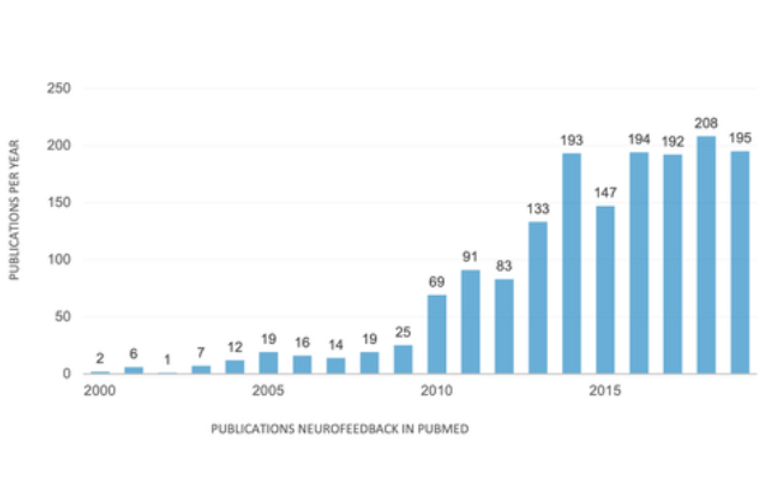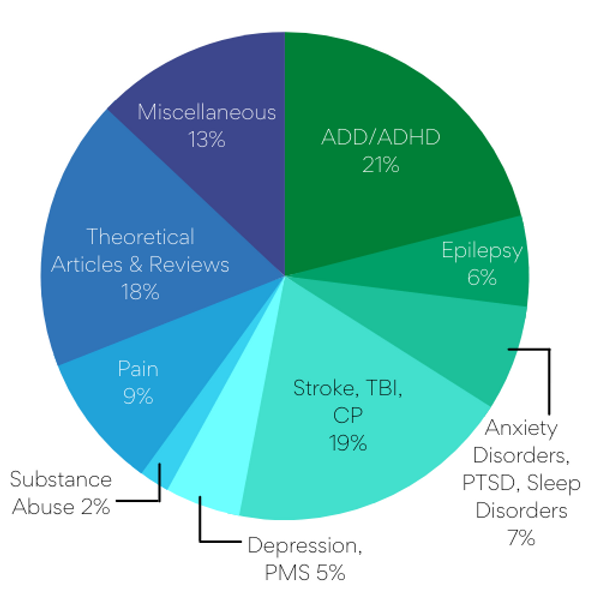Application clinique la plus récente du neurofeedback ILF
ADDICTIONS
Corominas-Roso, M. et al. (2020). Benefits of EEG-Neurofeedback on the Modulation of Impulsivity in a Sample of Cocaine and Heroin Long-Term Abstinent Inmates: A Pilot Study. International Journal of Offender Therapy and Comparative Criminology, 64(12), 1275-1298.
Téléchargement
Leong, S. L., Vanneste, S., Lim, J., Smith, M., Manning, P., & De Ridder, D. (2018). A randomised, double-blind, placebo-controlled parallel
trial of closed-loop infraslow brain training in food addiction. Scientific reports, 8(1), 1-9.
Téléchargement
TDAH (Trouble Déficit de l'Attention avec ou sans Hyperactivité) & SPECTRE DU TROUBLE AUTISTIQUE
Asadpour, V. (2021) Therapeutic Effect of Infra-Low-Frequency Neurofeedback Training on Children and Adolescents with ADHD. In Brain-Computer Interface (1-18), Schneider, H., Riderle, J. & Seuss, S.
Téléchargement
Coben, R., Linden, M. & Myers, T.E. (2010). Neurofeedback for Autistic Spectrum Disorder: A Review of the Literature. Applied
Psychophysiology & Biofeedback, 35(1), 83-105.
Flatz, T. & Gleußner, M. (2014). Neurofeedbacktherapie bei ADHS und Autismus. Pädiatrie & Pädologie 49, 22–27.
Othmer S. & Othmer S.F. (2011). Neurofeedback for the Autism Spectrum. In K. Siri and T. Lyons (Eds.), Cutting-Edge Therapies for Autism (262-267). Skyhorse Publishing.
Schneider, H., Alfred, A., Wandernoth, B. and Blunck, A. (2019): Therapeutic effect of Infra-Low-Frequency (ILF-) Neurofeedback training on Children and Adolescents with Attention Deficit (Hyperkinetic) Disorder. Clinical Neurophysiology, 130, 8, e125-e126. Conference Abstract at the 63rd Annual Meeting of the German Society for Clinical Neurophysiology and Functional Imaging (DGKN)
Téléchargement
DEPRESSION
Grin-Yatsenko, V. A. et al. (2018) Infra-low frequency neurofeedback in depression: Three case studies. NeuroRegulation 5, 30–42.
Téléchargement
MIGRAINE
Dobrushina, O., Arina, G., Osina, E. & Aziatskaya, G. (2017). Clinical and psychological confirmation of stabilizing effect of neurofeedback in migraine. European Psychiatry, 41.
Téléchargement
TROUBLES DE L'ALIMENTATION
Chirita-Emandi, A., & Puiu, M. (2014). Outcomes of neurofeedback training in childhood obesity management: A pilot study. Journal of Alternative and Complementary Medicine, 20(11), 831–837.
Téléchargement
FIBROMYALGIE, SCLÉROSE EN PLAQUES, COMMOTION CÉRÉBRALE
Dobrushina, O. R., Varako, N. A., Kovyazina, M. S. & Zinchenko, Y. P. (2016). Combination of Neurofeedback and cognitive training in attention deficit due to multiple sclerosis. Int. J. Psychophysiol. 108, 118.
Téléchargement
Ingvaldsen, S. H. (2019). QEEG and Infra-Low Frequency Neurofeedback Training in Fibromyalgia: A Pilot Study (Master's thesis, NTNU).
Téléchargement
Lamprecht, C. E. (2019). The effect of neurofeedback in post-concussion syndrome. Doctoral dissertation, Stellenbosch University.
TRAUMA / TSPT (TROUBLE DE STRESS POST-TRAUMATIQUE)
Gerge, A. (2020). A multifaceted case-vignette integrating neurofeedback and EMDR in the treatment of complex PTSD. European Journal of Trauma & Dissociation, 4(3), 100157.
Téléchargement
Othmer, S. & Othmer, S. F. (2009). Post Traumatic Stress Disorder—The Neurofeedback Remedy. Biofeedback 37, 24–31.
Téléchargement
Othmer, S., Othmer, S. F. & Legarda, S. B. (2011). Clinical Neurofeedback: Training Brain Behavior. Treat. Strateg. Pediatr. Neurol. Psychiatry 2, 67–73.
Nilsson, R. M. & Nilsson, V. (2014). Neurofeedback Treatment for Traumatized Refugees-A Pilot Study. Lund University, Department of Psychology.
Téléchargement
Rogel, A., Loomis, A. M., Hamlin, E., Hodgdon, H., Spinazzola, J., & van der Kolk, B. (2020, July 13). The Impact of Neurofeedback Training on Children With Developmental Trauma: A Randomized Controlled Study. Psychological Trauma: Theory, Research, Practice, and Policy. Advance online publication. http://dx.doi.org/10.1037/tra0000648
Téléchargement
van der Kolk, B., Hodgdon, H., Gapen, M., Musicaro, R., Suvak, M.K., Hamlin, E., & Spinazolla, J. (2016). A Randomized Controlled Study of Neurofeedback for Chronic PTSD. PLoS ONE 11(12): e0166752.
Téléchargement
TROUBLES NEUROLOGIQUES RÉFRACTAIRES (ÉPILEPSIE, INFIRMITÉ MOTRICE CÉRÉBRALE, AUTISME)
Legarda, S. B., McMahon, D., Othmer, S. S. & Othmer, S. S. (2011). Clinical neurofeedback: Case studies, proposed mechanism, and implications for pediatric neurology practice. J. Child Neurol. 26, 1045–1051.
Téléchargement
Strehl U., Birkle M., Wörz S. & Kotchoubey B. (2014). Sustained reduction of seizures in patients with intractable epilepsy after self-regulation
training of slow cortical potentials - 10 years after. Frontiers in Human Neuroscience, 8, 604.
Téléchargement
ACCOUPHENES
Güntensperger, D., Thüring, C., Meyer, M., Neff, P. & Kleinjung, T. (2017). Neurofeedback for Tinnitus Treatment - Review and Current Concepts. Frontiers in Aging Neuroscience, 9,386. (Attn: they have primarily used frequency band NFB training in their studies and are (just) referring to ILF-NFB
Güntensperger, D. (2018). Treatment of chronic tinnitus with neurofeedback. (Doctoral Dissertation, University of Zurich). (Attn: they have primarily used frequency band NFB training in their studies and are (just) referring to ILF-NFB)
Leong, S. L., Vanneste, S., Lim, J., Smith, M., Manning, P., & De Ridder, D. (2018). A randomised, double-blind, placebo-controlled parallel trial of closed-loop infraslow brain training in food addiction. Scientific reports, 8(1), 1-9.
Téléchargement
Prinz, W. (2015). Neurofeedbacktherapie als Spezialtherapieangebot. psychopraxis. neuropraxis 18, 180-183. (in German)
LESION CEREBRALE TRANMATIQUE (LCT)
Carlson, J. & Ross, G.W. (2021). Neurofeedback Impact on Chronic Headache, Sleep, and Attention Disorders Experienced by Veterans with Mild Traumatic Brain Injury: A Pilot Study. Biofeedback, 49(1), 2-9.
Téléchargement
NEUROFEEDBACK EN RÉALITÉ VIRTUELLE DANS LE TRAITEMENT DE LA DOULEUR
Orakpo, N., Vieux, U. & Castro-Nunez, C. (2021). Case Report: Virtual Reality Neurofeedback Therapy as a Novel Modality for Sustained Analgesia in Centralized Pain Syndromes. Frontiers in Psychiatry, 12, 418. DOI: 10.3389/fpsyt.2021.660105
Téléchargement
Livres et chapitres de livres sur le neurofeedback ILF
Kirk H. (2015) Restoring the Brain: Neurofeedback as an Integrative Approach to Health. CRC Press, Taylor and Francis Group. esp. Chapter 11, Neurofeedback in application to the ADHD spectrum, R. Sasu & S. Othmer
Téléchargement
Othmer, S. & Othmer, S. F. (2011). Performance Enhancement Applications of Neurofeedback. In Case Studies in Applied Psychophysiology: Neurofeedback and Biofeedback Treatments for Advances in Human Performance 17–30. Wiley-Blackwell.
Othmer S. (2019). Protocol Guide for Neurofeedback Clinicians, 7th Edition. EEG Info

